HOUSEPLANTS THAT PURIFY INDOOR AIR

When we think of air pollution, we invariably think of the outdoors. Of big, industrial chimneystacks spewing black smoke into the air, of poisonous auto emissions, toxic solid waste piles etc. It is hard to fathom therefore, that our indoor air is actually 2 to 5 times more polluted than the outdoor air we’re constantly worrying about.
And one of the first indications of poor indoor air quality is felt by the eye.
Indoor contaminants stagnate in the air due to lack of ventilation and faulty heating and air-conditioning ducts. Add to this, all the toxic volatile organic compounds (VOC) released by cleaning agents, paint, carpet and furniture; Biological contaminants introduced by pests, pet dander, dust mites and mold; Combustible contaminants emitting from fireplaces, gas stoves, heating furnaces…the list goes on.
Ninety per cent of an average human life is spent indoors, and that means our eyes are constantly exposed to these toxins. Result? Chronic Dry Eyes Syndrome, redness, itching, allergies and infections like conjunctivitis (pink eye).
An extremely effective – and aesthetic – way to cleanse the air in your home or office is by decorating with a variety of toxin-absorbing indoor plants. The use of plants as decontaminants is called Phytoremediation, and studies show that introducing the right kind of greenery in your living space can remove as much as 90 per cent of harmful airborne chemicals in only 24 hours!
Chemicals such as formaldehyde, that comes from the most unexpected sources like carpets, linoleum, furniture glue, upholstery – even grocery bags and kitchen paper towels. Benzene from car emissions and use of gas-powered equipment in attached garages, trichloroethylene from metal cleaning and household degreasing material…etc.
Some indoor green plants are more efficient than others in purifying indoor air quality. The trick is to arrange the right kind of plants in groups – that is, have several of them in one area of the room. Here’s a list of indoor plants that are best suited for the job.
English Ivy
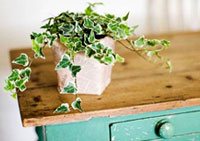 This plant is especially suitable for indoor living if you have pets, because English Ivy has the ability to reduce the amount of airborne fecal matter that can cause eye irritations and conditions like bacterial conjunctivitis (pink eye). The plant also neutralizes a fair quantity of formaldehyde that is circulating in your indoor air. Keep a few pots of English Ivy near your work desk, as the plant will absorb trace amounts of benzene that is often released into the air by office equipment.
This plant is especially suitable for indoor living if you have pets, because English Ivy has the ability to reduce the amount of airborne fecal matter that can cause eye irritations and conditions like bacterial conjunctivitis (pink eye). The plant also neutralizes a fair quantity of formaldehyde that is circulating in your indoor air. Keep a few pots of English Ivy near your work desk, as the plant will absorb trace amounts of benzene that is often released into the air by office equipment.
Spider Plant
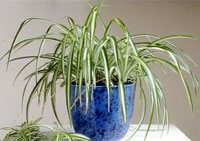 The best budget option, especially if you’re going to buy several pots to make a grouping in your home. An old, traditional indoor plant, the Spider is thrives and reproduces quickly in low and middle light. The Spider Plant leaves absorb harmful substances like traces of formaldehyde, carbon monoxide, benzene molecules, mold and other allergens, and it is especially beneficial if you suffer from dust allergies.
The best budget option, especially if you’re going to buy several pots to make a grouping in your home. An old, traditional indoor plant, the Spider is thrives and reproduces quickly in low and middle light. The Spider Plant leaves absorb harmful substances like traces of formaldehyde, carbon monoxide, benzene molecules, mold and other allergens, and it is especially beneficial if you suffer from dust allergies.
Lady Palm
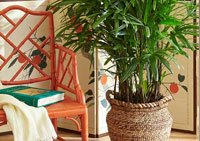 The Lady Palm takes a little time to grow, but once it does, the plant can reach a height of 6 feet. It’s leaves divide into beautiful, ribbed, fan-like segments, and look perfect when placed in a low-light corner of a room. The Lady Plant targets ammonia, which is a common ingredient in cleaners, dyes and some textiles, and cleanses the air of xylene and toluene as well.
The Lady Palm takes a little time to grow, but once it does, the plant can reach a height of 6 feet. It’s leaves divide into beautiful, ribbed, fan-like segments, and look perfect when placed in a low-light corner of a room. The Lady Plant targets ammonia, which is a common ingredient in cleaners, dyes and some textiles, and cleanses the air of xylene and toluene as well.
Peace Lily
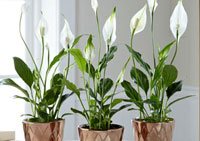 This is one of the few air-purifying plants that flower, and therefore has an aesthetic advantage. Peace Lily plants can improve your indoor air quality by as much as 60 per cent. They contain the spread of mold spores that grow inside the home by absorbing the spores and converting them to food. Place some Peace Lily plants in moist areas of the house, such as the bathroom, to keep mildew from infesting the shower tiles and curtains. They also absorb acetone, which is emitted by electronics, adhesives and house-cleaning agents. Be aware though, that this elegant plant with pretty white sail-shaped flowers can be hazardous if ingested by your pets.
This is one of the few air-purifying plants that flower, and therefore has an aesthetic advantage. Peace Lily plants can improve your indoor air quality by as much as 60 per cent. They contain the spread of mold spores that grow inside the home by absorbing the spores and converting them to food. Place some Peace Lily plants in moist areas of the house, such as the bathroom, to keep mildew from infesting the shower tiles and curtains. They also absorb acetone, which is emitted by electronics, adhesives and house-cleaning agents. Be aware though, that this elegant plant with pretty white sail-shaped flowers can be hazardous if ingested by your pets.
Boston Fern
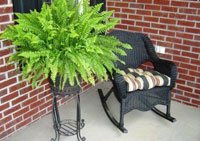 With its voluminous, curving fronds, the Boston Fern has been a popular indoor choice since the Victorian era, and you often see them in living rooms, displayed on show pedestals or hanging in plant baskets. It is a super efficient air purifier, and is especially good at removing formaldehyde. Boston Ferns remove other indoor pollutants too, such as benzene and xylene – both components of gasoline exhaust that drift indoors if you have an attached garage. On the downside, Boston Ferns need regular watering and plenty of sunlight, so choose to grow them indoors only if you’re ready to lavish a lot of TLC.
With its voluminous, curving fronds, the Boston Fern has been a popular indoor choice since the Victorian era, and you often see them in living rooms, displayed on show pedestals or hanging in plant baskets. It is a super efficient air purifier, and is especially good at removing formaldehyde. Boston Ferns remove other indoor pollutants too, such as benzene and xylene – both components of gasoline exhaust that drift indoors if you have an attached garage. On the downside, Boston Ferns need regular watering and plenty of sunlight, so choose to grow them indoors only if you’re ready to lavish a lot of TLC.
